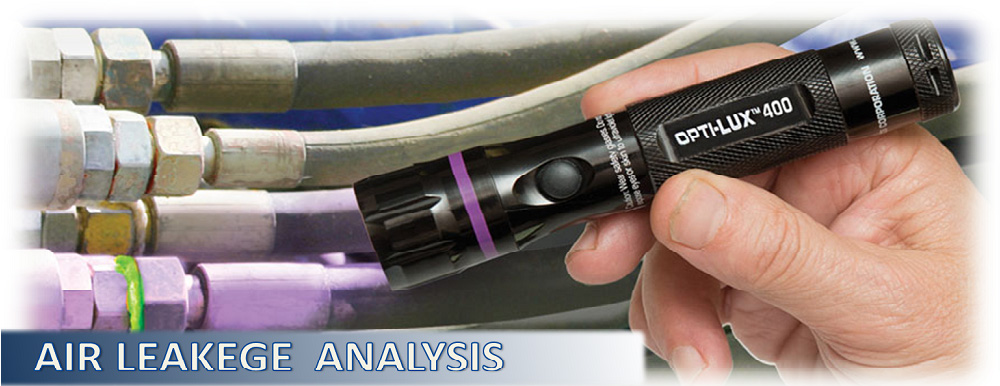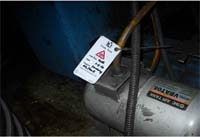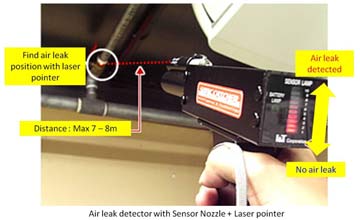
The Green Energy Associates uses the most advanced ultrasonic equipment available and continuously looks for improved methods and technology in detecting air leakages of compressed air system. These services are customized for all manufacturing industries of Pakistan, where we are wasting our money by air leakages due to unawareness and unavailability of air leakages testing equipments.
How we work:
As the name implies ultrasonic leak detectors detect the ultrasonic sound of the leak. You are probably familiar with the hissing sound a large leakage makes. Smaller leaks also emit sound; however the frequency is too high for our ears to detect it. By a process called heterodyning, the detector translates the ultrasonic hissing sound to a lower frequency where it can be heard through headphones and direct you to the source. As you get closer, the sound gets louder. If you decrease the sensitivity as you close in on the leakage it will pinpoint its exact location. Some leakages can be heard several meters away, therefore direct access to the leakage is not always necessary. As long as the leak is turbulent, there will be enough sound to be detected ultrasonically. Ultrasonic’s can detect pinhole leakages with a pressure as low as 0.5 bar, however, the more pressure behind the leak, the more turbulence there will be and the easier it becomes to locate actual leakage.
As the detector is focused on a specific band of sound, wind noise, voices, traffic and most normal operational sounds will not register. You can actually yell directly into the sensor and hear nothing. This means that leakage detection can be made during production hours which are a prerequisite for successful leakage detection as many leakages are production related. Leakage’s in many cylinders, valves or other pneumatic equipment are multi-positional and require detection over their full running cycles to appear. For the same reason, leakage detection done after production hours or in the weekend, only detects a fraction of the existing Because ultrasonic detectors do not “sniff” out the gas, they can easily locate leakages even under windy conditions.
Realistically, an ultrasonic detector will detect most of the leakages you encounter in an industrial environment. It is the only instrument that will pinpoint a vacuum leak, or detect any pressurized gas in any system. It is also more accurate for detecting larger leakages because its sensor will not become saturated or false alarm from the presence of gas in the atmosphere.
A reporting system – Essential for leakage detection
A successful leakage detection program is dependent on an effective reporting system. It should keep your company firmly on a documented track to reduced leakage levels. Therefore it should be just as focused on the identification of leakages as of their causes. Correctly implemented and supported it will provide vital data on where the leakages are reoccurring, which components and equipment cause repeated problems, which workplaces need closer attention, appropriate service interval suggestions etc. Without a reporting system, people responsible for documentation and repair you will be far from achieving the results possible. Due to the nature and cost of leakages a poorly managed system can be of great economic consequence.
All members of the Green Energy Associates use the same system of identification and reporting of leakages which contains the following elements.

1. Establish a system for workplace identification.
Tagging or labeling.For easy repair and overview it is important that the located leakages are tagged or labeled with a number or identification that allows tracking. The Green Energy Associates uses a tagging system that indicates the degree of leakage.
Each tag contains the following information. Workplace identification number, tag number, date of repair, date for after-control and responsible person. Each tag also represents a volume of air leakages.
The number or classification of the leakage is used primarily as a priority guide when planning repairs and can only serve as a general guideline about the total leakage volume. A leakage of 1 mm is classified as a leakage that requires immediate attention just as a 6 mm leakage is. However the number of tags and their classification gives you a good idea of the state of the system and serves as a benchmark for continued leakage detection.
How to detect air leak

